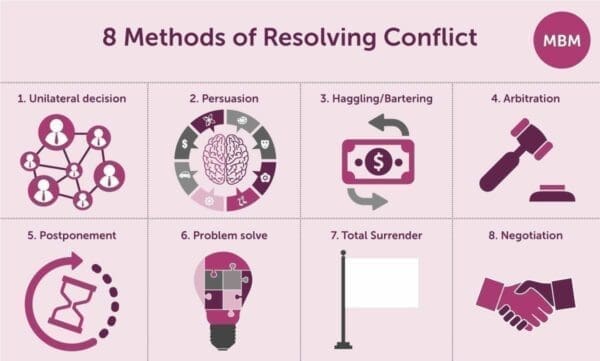What’s the Difference Between Haggling vs Negotiating?
Picture this: You’re on holiday abroad, the sun is shining, you’re relaxed, beer in hand, and you decide that tomorrow, you’ll make a trip to the market. Once at the market, you see a sign on a stall advertising sunglasses for 49 euros. You walk over to the stall, pick up a lovely pair of red sunglasses and open the bidding: “I’ll give you 10 euros.” The seller says they can’t accept such a low offer, and so the familiar story unfolds. Finally, you both agree on 15 euros.
You’re probably thinking you successfully negotiated, but you didn’t. Instead, you haggled. Don’t get me wrong, haggling is a valid form of resolving this type of conflict, but to me, it’s not negotiating. As a leader, you must be able to both haggle and negotiate — and know when one approach is needed over the other.
As a CEO, I have equipped myself to understand different methods of resolving these types of conflicts so that they don’t slow down my business.
I Believe There are Eight Ways:
1. Haggling or bartering: “I’ll meet you halfway.”
2. Total surrender: “Ok, we’ll agree to the deal.”
3. Unilateral decision: “No, we’re not giving in. That’s it.”
4. Persuasion: “It’s a no-brainer, so you should do it.”
5. Arbitration: “Ok, let’s ask them for their opinion.”
6. Postponement: “We’ll come back to this at the next meeting with a plan.”
7. Problem solving: “I’ve got an idea — how about if we do X, Y and Z?”
8. Negotiation: “If you do X, then I will do Y.”

I’d like to focus on haggling and negotiating. I’ve found many people often conflate the two terms. But when you haggle on price, you focus on a single variable; when you negotiate, you trade across multiple variables, such as price, time, quality, etc.
Does it matter if you don’t know the difference? Yes. By knowing there are multiple methods from which you may choose when you are in conflict, you can select the most effective option to resolve said conflict and ensure your decision is informed.
For example, with haggling, you’ll need to meet in the middle, so you can weigh the advantages and disadvantages of this. The advantage is that the other person might compromise, but the disadvantage is that you likely will need to, also. Furthermore, you cannot haggle on a conflict that involves many variables. So in those instances, you’ll know you need to negotiate, which is a skill that takes much more focus.
In short, as a leader, you need to know when to haggle and when to negotiate. Understand that the two disciplines are different and that each has its own advantages and disadvantages.

Haggling Best Practices
If you choose to haggle, I’ve found conditioning your opponent’s expectations can be helpful. For example, when you take your car into the mechanic’s and start explaining what’s wrong with it, you might be met with the mechanic shaking their head to imply the fix is going to be expensive. They are managing your expectations, which I call “conditioning.”
So, when the prices come your way during your haggle, your job isn’t to reply quickly with the next number. Instead:
1. Manage the other person’s expectations by shaking your head or displaying other equal behaviors that let them know if it is going to be tough to get the price they want.
2. Conceding slowly is also key. If the other party moves from $49 to $3, you might move from $15 to $17. This indicates that you don’t have much to play with.
That being said, remember that haggling has its place when the deals are small and the outcome matters less. For bigger deals that are more complex, negotiating is the way forward.
Negotiating Best Practices
Before you negotiate, you need to prepare. I’ve found most people don’t. Instead, they go straight for, “Here’s my proposal” and often find themselves arguing about the price and reverting to haggling. However, in my experience, there are four stages of negotiating:
1. Prepare: This stage is often missed because most people don’t know how to prepare effectively. You wouldn’t go to the gym without warming up, yet we often start negotiating from a cold start and end up in a deadlock. To prepare, you can look for free templates online that will help you plan your negotiation. Once you have a plan, you can build a presentation and share it once negotiations begin. I believe those who do prepare, do it by building a presentation.
2. Explore: This stage is also often missed because many people start negotiations with a proposal. Imagine going to a car dealership to buy a new car for your family, and you stop momentarily to look lovingly at a two-seater sports car. The salesperson comes over and starts proposing you should buy it because they have a “great deal.” \
If they’d only done the explore stage first, they’d know this is only a dream car and you’re looking to buy something else. The key to successfully navigating this stage is to act like a detective. Ask the other party questions about their intentions behind the negotiation. To help guide your questions, think of the five W’s and one H: what, when, which, why, who and how.
3. Propose: I’ve found the most famous tool of negotiating is saying, “If you … , then I …” You can use this wording at this stage to make a proposal.
4. Summarize: In this stage, often skipped also, is the opportunity to summarize what has been agreed.

Sticky Learning ® is 7 times more effective than 1-day training courses. Plus, you will get a Chain of Evidence proving your Return on Investment. Discover soft skills training that changes behaviours long term.

Final Thoughts on Haggling vs Negotiating
To be a successful leader or entrepreneur, you need to be good at negotiating and haggling. Otherwise, you might lose deals or find that you are working hard only to keep your suppliers’ pockets lined. For the big negotiations, prepare — and prepare well.
This haggling vs negotiating article was written by Darren A. Smith for Forbes.
Action: For even more useful content on negotiations, check out our ultimate guide on negotiation skills.




